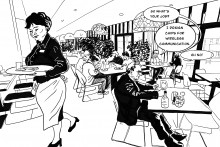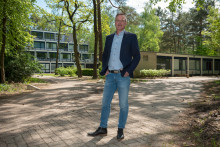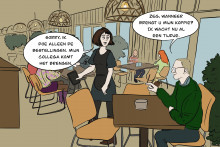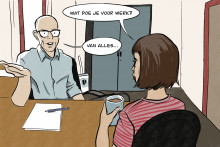Most of us don’t realise how much engineering work goes into everyday items and objects. We are glued to our smartphones, but we do not stop to consider the person designing these devices. ‘It is a hidden world,’ says Eric Klumperink. ‘It’s rare to see an electrotechnical engineer being interviewed on TV too.’
As Klumperink explains his research over the phone, a chip converts his voice into digital data packets that enter the air via radio waves. It is not just the telephone conversation that travels this way: radio programmes, YouTube videos, e-mail messages, Bluetooth signals - wireless communication is all around us at all times.

Klumperink is looking for ways to design radio chips that can facilitate this wireless communication even faster and cheaper. That starts with brainstorming discussions, he says. 'We read or hear at conferences what exists, which triggers new ideas. We then argue whether a new chip design could work. This design is then put into a computer programme and if the results are good, we have a chip made in a factory.’
After about three months, the chip is ready for testing; the most daunting phase. ‘Something may seem excellent in a computer model and turn out unusable. We can model all manner of physical effects, but you can never be sure it will work properly.’
For example, a student once discovered that the noise in a transistor diminishes when it is switched off and on. The computer models did not predict that. 'If the measurements do not match the calculations, you make new discoveries. Such surprising turns are the most fun, although it can also be frustrating if you still don't know why that stupid chip doesn't work years later.'
Klumperink may be a whizz with wireless communication, he is not as great at communicating about his research. He’s doing a great job, effortlessly giving examples off the top of his head to paint a relatable picture for his conversation partner. Going in-depth is more difficult, especially in an informal setting. ‘Even a term like ‘frequency’ is too abstract for many people. Most of them are more interested in the impact of my research. Some people are worried about radio wave emissions because of things they read on the Internet, and if they don’t really understand the subject, they have many questions.’
Public interest has increased a little since the 80s. The researcher can tell because of the influx of students. ‘This technology harbours plenty of jobs and great careers. To me, it’s a fun jigsaw; we’re piecing together the chip components.'
Klumperink likes sharing this enjoyment with kindred spirits. Special friendships have formed in a select group of people who work together on assessing new solutions at conferences. ‘We’re all of an ilk, a certain personality with a certain sense of humour. It’s difficult to explain, a kind of shared subculture. For instance, we say: ‘Oops, it looks like it might be working!’ Time to take our demands up a notch.’











